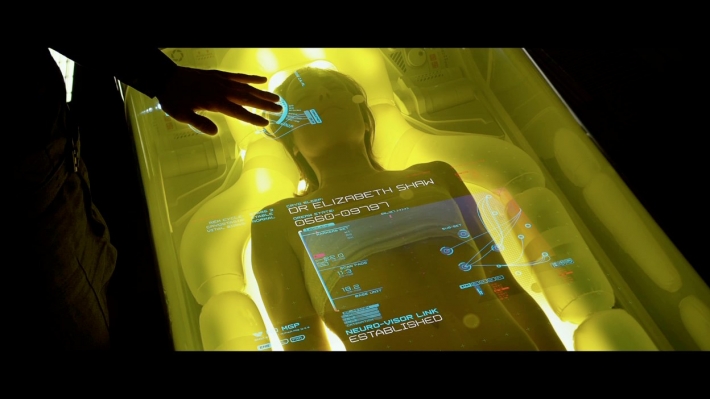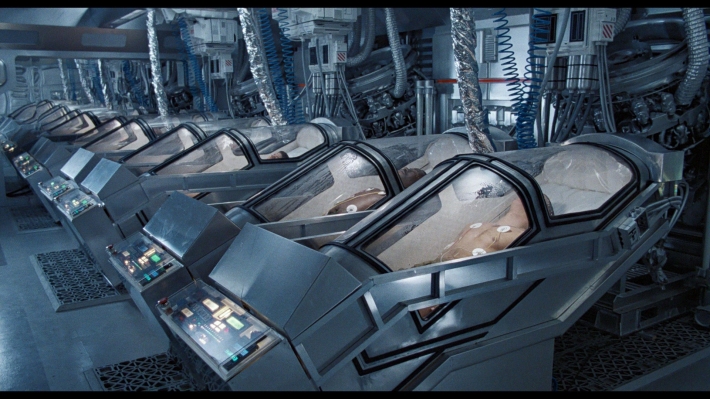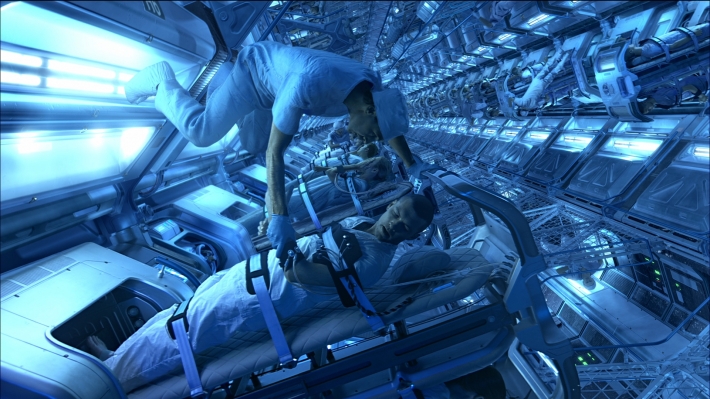Astronaut hibernation, 'stasis' or 'hypersleep' has allowed writers of fiction to move their protagonists into deep space, overcoming both the problems of long-distance space travel and allowing for swifter movement of the plot. As technology in the real world is developing to travel across greater distances in space, astronaut hibernation is becoming more imminently necessary as a solution to the many expected problems.
Manned missions to Mars are apparently becoming an increasing possibility (though Mars One is unlikely to prove pioneers of such deep space travel). Using traditional propulsion technology, a 6-9 month journey to Mars could be expected. This is a large portion of an astronaut's life to spend travelling across space in an isolated environment and large amounts of resources would be required to sustain the travellers across this period of time. The ship would need to be well-stocked with food, water and other consumables and large living spaces for the volume of astronauts. They would also require exercise equipment to counter the bone loss and muscle atrophy caused by microgravity. NASA are currently attempting to develop a super fast system of propulsion, using nuclear fusion rockets, which would reduce travel time and the need for hibernation. However, even with more powerful propulsion systems, astronaut hibernation would still be essential to cover truly great distances.
As astronauts in hibernation would need fewer resources and smaller living areas, there would be a positive impact on the design of the ship. There would be no need for large pressurised living spaces or artificially generated gravity. Greater numbers of people could be packed onto the ship. In addition, astronauts embarking on deep space travel would be at high risk from the effects of radiation. However, if they are put into hibernation, shielding from radiation could be added to the sleeping capsules of the crew instead of the whole of the ship. This would cost far less and would reduce the overall weight of the ship, making it speedier and easier to manoeuvre.
Long-distance travel into deep space is bound to have physical and psychological effects on astronauts. If astronauts are immobilised in sleep capsules for the duration, they would not need to be mentally active to prevent themselves from going insane and they would be less likely to feel the isolating effects of the journey. The astronauts would not need to feed, as their condition would be monitored by the ship's computer and they would be fed intravenously. This has associated benefits and risks. The ship would be able to monitor the body's processes very carefully and possibly with more accuracy than if the subject was feeding themselves. However, the astronauts' lives would be dependent upon the computer. If the system failed and they came out of sleep, the ship would not be designed or sufficiently equipped to support a large number of people out of hibernation.

Credit: 20th Century Fox
In the film prequel to the 'Alien' trilogy, 'Prometheus', the hypersleep chambers manufactured by Weyland Corporations communicate with the ship's mainframe computer to monitor the metabolic conditions of the inhabitants. It is clearly a priority to maintain the astronauts in this state for the entire journey, as the chamber's function is supported by a back-up system of zero-loss lithium ion batteries. These will maintain the processes of the chamber for up to 100 years in case of emergency. It seems evident that in the event of a problem with the hibernation systems, the ship would not be able to sustain the astronauts and so it is vital that they are kept in suspended animation. In the 1968 film '2001: A Space Odyssey', the crew of 'Discovery One' face the dire consequences of having their ship monitored and controlled by a sentient mainframe computer. HAL 9000 monitors the overall running of the ship and is programmed to ensure the success of the mission. This determination is crucial to ensuring the crew's safety while they are in hibernation, but problems arise when this conflicts with the intentions of the crew.
Despite the many benefits of hibernation, the effect of micro gravity on the astronauts' physical health would remain a problem. As they would be unable to move and exercise under gravity for long periods of time, astronauts are likely to suffer from muscle atrophy and bone loss. Study of long hibernating animals could provide some clues towards developing therapies to prevent muscle loss in low gravity. Studies have already shown that bedridden patients retain more strength if they receive daily doses of a drug called dobutamine, which boosts the strength of heart muscles. However, full body strength and fitness is of concern. It has been suggested that artificial gravity could be induced by spinning the spacecraft at high speed as it travels. The unconscious astronauts would be insusceptible to its disorientating effects, though they would benefit from the effect of gravity.
Many science fiction films featuring astronaut hibernation seem to depict a system based on cryonics, which involves extremely low temperatures to reduce body processes for preservation of the human body. An overwhelming use of blue light in these scenes implies that the directors want us to believe the chambers are cold, extremely cold. (Alternatively, the blue light may be an attempt to create a calming atmosphere, though I'm sure this sort of sleeping aid would have insignificant effect next to the metabolism-stopping super-cooling effect of cryonics) For example, in the classic 1979 film 'Alien' the method of astronaut hibernation is referred to as 'cryosleep' and the astronauts' body processes are taken down to zero. The mechanics are not explained in detail in the films, though the novelisation describes chambers filled with a viscous fluid when the chambers are in operation. This would suggest that the cooling mechanism is dependent on the fluid and that 'cryosleep' is chemically-induced. However, in reality it is unlikely that hibernation for deep space travel would involve such extreme cooling processes as involved in cryogenics. The reduction in metabolism would be more moderate and would more resemble the hibernation of animals on Earth. A 10° drop in body temperature reduces the metabolic rate by 50-70%, resulting in hypothermia and loss of consciousness. This is a huge drop in metabolism for a relatively small drop in temperature, but is still no where near as great as the drop involved in cryonics.

Credit: 20th Century Fox
The Cryonics Institute in Michigan offers patients the opportunity to be frozen after death, in the hope that they will be revived at a point in the future when medical science has advanced and death, disease and ageing have been eliminated. Whereas hibernation slows the metabolism, a cryonically-frozen patient's metabolism either has already stopped or is stopped entirely and the results upon unfreezing are highly unpredictable. Cryonic freezing should be unnecessary for astronaut hibernation, which is more likely to involve the slowing of the metabolism exhibited by hibernating animals on Earth. This requires a cooling of the body, by just enough to induce a loss of consciousness.
One problem that needs to be overcome is the question of how to cool an astronaut's core sufficiently to cause this unconscious state. This could be done using gel pads that doctors use during hypothermia therapy. A more invasive solution would be to inject fluids straight into the blood stream. The viscous fluid depicted in the 'cryosleep' chambers in 'Alien' could intentionally play a part in helping to cool the astronaut's core, by submerging their bodies in a cooling fluid. However, it would still have to remain outside the body and so would not be completely effective as a method of cooling the body's core. Viscous fluid in the bloodstream and respiration systems would cause serious problems when the astronaut awoke.
Experiments to achieve suspended animation over a short time period have included temperature-induced and chemically-induced methods. Hibernation in mice has been achieved by placing them in a chamber of hydrogen sulphide. Induced hibernation in humans has not yet been achieved intentionally, though there are examples of injured people having been frozen for hours or days in cold environments and having awoken with no side effects. If such results could be achieved in the laboratory, then it would have many uses beyond deep space travel. For example, the lives of terminally ill and injured people could be saved by putting them in a state of suspended animation until treatment can be given. This could be as simple as keeping someone's condition stable for long enough to get them to a hospital, or more speculatively, preserving someone's body until medical science has advanced sufficiently to produce treatment that was not available when the person fell ill. It could also be used to preserve organs for transplant, so the organs would be fresher, potentially improving the success rate of transplant.

Credit: 20th Century Fox
In recent years, research conducted by Italian universities on behalf of the European Space Agency has resulted in successful attempts to induce hibernation in non-hibernating animals, using a synthetic molecule called DADLE. A research team at the University of Pavia first succeeded in creating a hibernation-like state in cell cultures, as DADLE's opium-like qualities reduce the energy consumption in cell cultures. The University of Vernona built upon this research by testing DADLE on rats and monitoring the subsequent behaviour, heart and brain activity. The results showered huge drops in heart rate, body temperature and metabolism, symptoms characteristic of hibernation. The rats were anaesthetised and observed in a magnetic resonance scanner to check the state of their organs. The researchers noted a significant reduction in body temperature up to 90 minutes after DADLE was injected. This gives some indication of the length of time a rat could hibernate for using this method, though the results may not be so prolonged with human subjects. If there were no serious side-effects, further injections of DADLE are a possibility to extend the period of hibernation, but there has been no research done yet into the effect of DADLE on humans.
The hibernation practices of various animals could be looked to in order to find solutions to some of the problems encountered. For example, Alaskan black bears hibernate for up to seven months a year, without eating or drinking, and wake up in practically the same physical state that they went to sleep in. During this time, their heart rate is reduced to as low as nine beats a minute and their metabolism slows by three quarters. A study published in the Feb 2011 issue of 'Science' monitored the state of bears during their period of hibernation. The results showed an unusually great drop in the bears' metabolism for such a minimal drop in body temperature. It was also a surprise that the bears' metabolism remained suppressed for several weeks after the animals emerged from their dens. Research into the metabolic processes of black bears could provide some solutions for the problems with putting humans into suspended animation for long periods of time.
Though not yet achieved in humans, progress is being made towards putting non-hibernating animals into suspended animation for extended periods of time, and it may not be long until these methods can be applied to humans. It may be a while until humans can spend years in a state of hibernation for deep space travel, but the successes on the way to achieving this will provide valuable solutions in medicine. Organ preservation for transplant and full body preservation for delayed treatment are two huge benefits of the technology which have been less-widely adopted into science fiction, but would have a greater impact in the real world. For this, the hibernation process needs to be perfected over a longer period of time and the safety and protection of organs and cells needs to be guaranteed. Only then could we contemplate astronaut hibernation as an viable solution to the effects of deep space travel. It is beginning to look increasingly likely that humans will be capable of travelling to, and possibly colonising deep space, though maybe not for some time.
References & Further Reading
- '2001: A Space Odyssey', Metro-Goldwyn-Mayer (1968).
- 'Alien', Brandywine Productions (1979).
- Foster, 'Aliens' novelisations, Warner Books (1979-1997).
- 'Prometheus', Brandywine Productions (2012).
- Biggiogera et al, 'DADLE: A Cue To Human 'Hibernation'', Journal of the British Interplanetary Society (2006).
- Fuardo et al, '[d-Ala2,d-Leu5]-enkephalin (DADLE) and morphine-induced postconditioning by inhibition of mitochondrial permeability transition pore, in human myocardium', Exp Biol Med (May 2013).
- Malatesta et al, 'Hypometabolic Induced State: A Potential Tool In Biomedicine And Space Exploration', Reviews in Environmental Science and Biotechnology (2007).
- Sullivan et al, 'Prevention of bedrest-induced physical deconditioning by daily dobutamine infusions. Implications for drug-induced physical conditioning', Journal of Clinical Investigation (1985).
- Tøien et al, 'Hibernation in Black Bears: Independence of Metabolic Suppression from Body Temperature' Science (Feb 2011).
- The Cryonics Institute
Listing image: John Liberto
